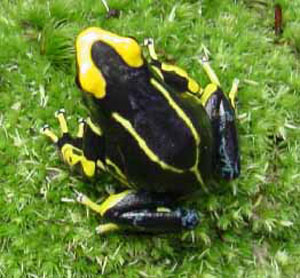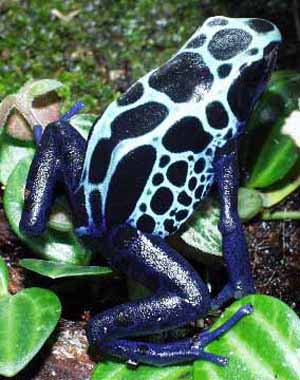Poison Dart Frog
Poison-dart frogs come from South and Central America. In the wild poison-dart frogs eat certain types of insects etc. that scientists believe then build up as alkaloid skin toxins and thus create the "poison". For most of the 167 species these toxins just make the frogs taste unpleasant to predators. However, there are three very toxic species of dart-frogs that are known for poisoning blowgun darts. Poison-dart frogs that are hatched and raised in captivity are said to not be at all poisonous because their diet lacks the necessary substances for the production of these toxins - still when handling - wear gloves. Also, being that there are so many species that are considered dart frogs - you will find that different species have different needs - mainly in housing.
DO NOT FEED WILD INSECTS OR INSECTS FOUND AROUND THE HOUSE – THEY MAY CARRY DISEASES AND PESTICIDES THAT COULD BE DEADLY TO YOUR PET
Average Size - Due to the varied species the size will vary. Most are around 2"
Life Span - most poison-dart frogs can live upwards of 7-15 years
Diet - Young frogs should be fed pinhead crickets or fruit flies. For adults - crickets, wax worms and fly larvae. For the small thumbnail frogs their diet will consist mostly of fruitflies, springtails, woodlice and similar small insects. 
Feeding - A meal of 3-4 pinhead crickets daily is a good starting point, although some experts recommend feeding mature frogs only every other day. Again, for the small varieties feed enough fruitflies so that within about 2 hours most are gone. I have left fruitflies that have not been eaten in the habitat without any outward problems with my frogs. Prey items should be gut loaded (feed nutritious foods such as fruits, vegetables, dog food, fish food etc.) before being given to the frog. Once weekly dust the insects with a complete reptile vitamin mix.
Housing - Young frogs can be kept in a small "pet keeper" (plastic 1 quart tanks with a plastic mesh top that has a small hinged door that can be purchased from any pet store) for several months. For adults, you can keep several (same species) in a twenty gallon aquarium so long as sufficient hiding spots are maintained. I have read that they can be kept in small tanks - I like giving them room to move about. If fighting occurs - separate the poison dart frogs - failure to do so can result in one dead.
Adults - Terrestrial species, such as, auratus, azureus, leucomelas and tinctorius, provide a terrarium with more ground space than height. Arboreal species, such as, “thumbnails,” ventrimaculatus, pumilio, and fantasticus prefer tall terrariums that offer multiple platform and plant levels and a combination of ground space and height should be provided for species, such as, galactonotus, tricolor and other semi-arboreal species.
Substrate - a combination of soil and peat moss, covered with a commercial reptile bark substrate and sphagnum moss can be used on the terrestrial side. The depth should be at least 2-3 inches to allow burrowing. Gravel can be used on the aquatic side. It is extremely important to use smooth gravel only (to prevent skin abrasions and injuries), and ideally the gravel should be large enough not to be swallowed. Add branches, artificial plants and live plants such as ficus as "furniture".
 Temperature - the tank can be kept at room temperature 70-80 F, although a temperature drop at night is a good idea (down to high 60's F lowest). Temperature - the tank can be kept at room temperature 70-80 F, although a temperature drop at night is a good idea (down to high 60's F lowest).
Lighting - Poison dart frogs are diurnal (daytime animals), as opposed to nocturnal, and display vivid colorations in striking patterns as a means of warning potential predators of their toxic skin secretions. You will need a UVA/UVB fluorescent light or MV light. Just make sure the frog can't jump onto the lamp. A light cycle of about 10 hours light to 14 hours dark is recommended by some keepers.
Water - the water used must be dechlorinated. Use a product from the pet store designed to remove chorine (and chloramine, if your water supply is treated with chloramine) to be safe. Filtration is not a necessity, but doing a 50% water change on a regular basis (at least twice weekly, perhaps more) is necessary. I use a small shallow bowl from a petshop ment for reptile enclosures. It dries out within 24-48 hours. I just wipe it down and refill with chlorine free water.
Humidity - Keep humidity at approximately 60%. If you opt for no water section and just use a bowl - mist the enclosure at least once each day. Get moss damp - do not allow a puddles to form on the land side of the enclosure
Recommended Supplies:
- Habitat with secure lid - screen with extra small holes if feeding fruit flies
- Basking rock or log and live plants (lots)
- Humidity gauge
- Substrate/commercial mulch
- Book about dart frogs
|
- Fish net or scoop
- Incandescent light or ceramic heater if habitat is in a cold area
- Thermometer
- Vitamin/mineral supplement
|
Habitat Maintenance Change water daily. Thoroughly clean the tank at least once week: set frogs aside in a secure habitat; remove any dead insects mold or fungus that may be growing in damp areas; rinse thoroughly with water, dry the tank and furnishings; and add clean substrate
Grooming and Hygiene When cleaning housing, check frog for any abrasions, signs of parasites or fungal infections. Always wash your hands before and after touching habitat contents to help prevent Salmonella and other infectious diseases. Remember - wear gloves when handling your poison dart frog.
Determining the sex of dart frogs - Due to varied species, there are different ways to determine the sex and different ways they will mate. All tadpoles will obviously need water and should eat flaked fish foods and algae.
Signs of a Healthy Pet:
- Clear eyes
- Clear nose and mouth
- Active and alert
|
- Eats regularly
- Healthy skin
| Common Health Issues and Red Flags:
- Vomiting
- Discharge in nose or mouth
- Lethargy
|
- Abnormal feces
- Decreased appetite
- Cloudy eyes
| If you notice any of these signs, please contact your exotic animal veterinarian.
As with all pets in this category, it is important that you find a veterinarian that practices in EXOTICS – this is critical. The typical small animal practitioner may not have sufficient knowledge in this area. Even this guide is general in nature and should not be used to diagnose your pet.
|



 Temperature - the tank can be kept at room temperature 70-80 F, although a temperature drop at night is a good idea (down to high 60's F lowest).
Temperature - the tank can be kept at room temperature 70-80 F, although a temperature drop at night is a good idea (down to high 60's F lowest).